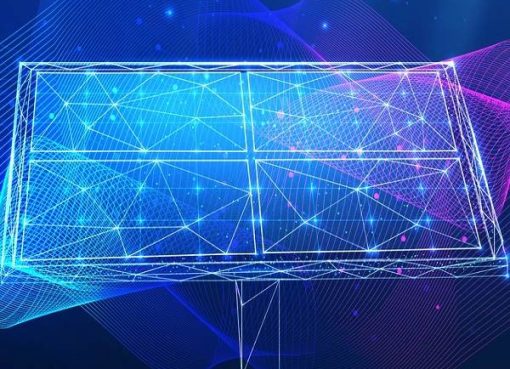Jupiter is the fifth planet that orbits the Sun, positioned between Mars and Saturn at an average distance of around 778 million kilometers (484 million miles).
It’s the largest of the Solar System’s four ‘gas giants‘ – massive planets largely made up of mostly light elements primarily in gas form.
Jupiter is more than twice as massive as all the other planets in the Solar System combined
Jupiter was the first planet in our Solar System, and it’s also the most massive. In fact, it’s actually 2.5 times the mass of the other planets in our Solar System combined.
All of that mass is squeezed into a sphere just under 140,000 kilometers (around 87,000 miles) across, giving it huge gravitational pull that likely shaped the orbit of Earth and the rest of the planets in our neighborhood.
The gargantuan planet takes about 12 Earth years to complete its orbit, yet its atmosphere rotates at an incredible rate, completing on average (depending on their latitude) ‘day’ in just under 10 hours.
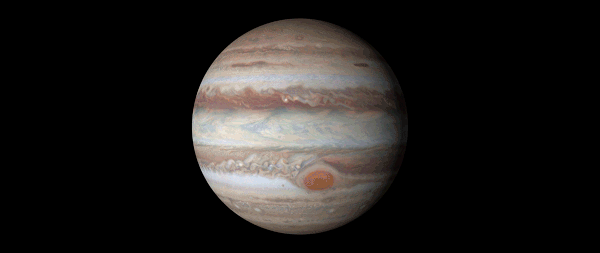 Hubble portrait of Jupiter rotating. (NASA/ESA/Goddard/UCBerkeley/JPL-Caltech/STScI)
Hubble portrait of Jupiter rotating. (NASA/ESA/Goddard/UCBerkeley/JPL-Caltech/STScI)
The gas giant doesn’t have a surface
There is no sharp distinction between the gases making up Jupiter’s atmosphere and its dense, liquid hydrogen core.
Below this line, matter slowly compresses into strange states.
Above it, layers of red and white clouds containing ammonia, ammonium hydrosulfide, and water rise in warming zones and fall in cooling bands, tumbling over one another as winds push and shove them around in violent storms.
Its famous Great Red Spot is shrinking
One such storm, called the Great Red Spot, has been swirling for nearly two centuries, if not more.
Though once big enough to swallow three Earths with room to spare, its girth has shrunk in recent years, prompting astronomers to wonder if it was growing weaker. More recent assessments make any imminent end to the large hurricane unlikely.
Interestingly, Hubble data have recently shown that the winds around the Great Red Spot appear to be speeding up.
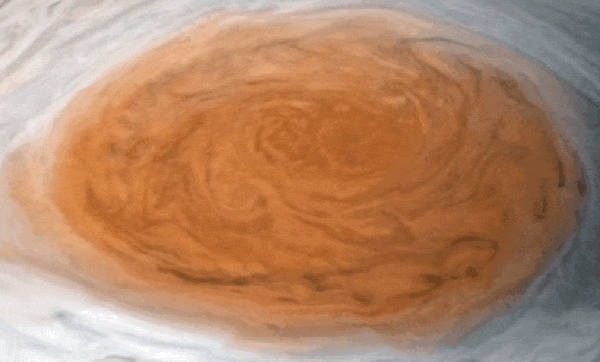 (NASA/JPL-Caltech/SwRI/MSSS/Gerald Eichstadt/Justin Cowart)
(NASA/JPL-Caltech/SwRI/MSSS/Gerald Eichstadt/Justin Cowart)
Jupiter emits more energy than it receives
At five times the distance from the Sun as Earth, it receives just a few percent of the sunlight.
This means Jupiter emits around 1.6 times the energy it receives from the Sun, whipping its thick atmosphere into intense weather systems as it rises from below.
The gas giant is sometimes called a ‘failed star’
At the very core of this hot, dense ball, hydrogen is thought to transform into a metallic state that physicists are still working to understand.
While Jupiter is larger than some stars, it’s sometimes referred to as a ‘failed star’ because it doesn’t have anywhere near enough mass to fuse hydrogen into helium. The planet is actually not a true failed star – this title belongs to brown dwarfs, which fill the gap between gas giants and true stars.
Jupiter’s magnetic field is 20,000 times more intense than Earth’s
Currents in this flowing state of charged hydrogen inside Jupiter could be what’s responsible for the planet’s intense magnetic field, one that is up to 20,000 times more intense than Earth’s and stretches a distance wider than the Sun’s diameter.
These powerful magnetic channels accelerate electrons to extreme energies, producing some of the most brilliant displays of auroras in the Solar System.
While auroras are permanent fixtures around the gas giant’s poles, we actually can’t see them with the naked eye because they glow in non-visible wavelengths.
Recent data from the Jupiter probe Juno and X-ray space observatory XMM-Newton showed that the auroras are caused by vibrations along the planet’s magnetic field lines generating plasma waves – a similar process to the one that produces auroras here on Earth.
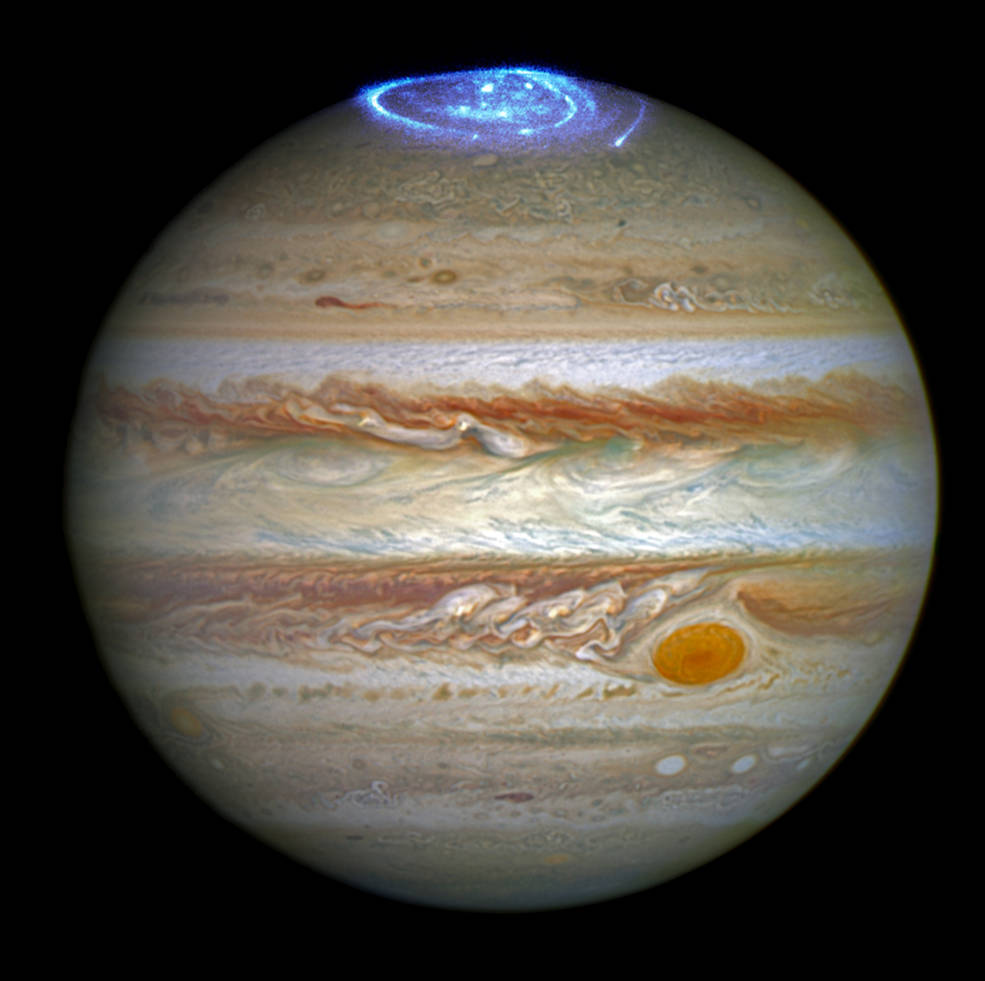 Hubble image of Jupiter’s auroras. (NASA/ESA/J. Nichols, University of Leicester)
Hubble image of Jupiter’s auroras. (NASA/ESA/J. Nichols, University of Leicester)
Jupiter has 53 moons
Unlike Earth, Jupiter’s wide orbit and powerful gravitational pull have captured scores of rocks of various sizes over the eons.
Officially, there are 53 objects orbiting Jupiter that have names. Four of them – Io, Europa, Ganymede, and Callisto – have been scientifically observed ever since their movements were first described in detail by the Italian astronomer Galileo Galilei in the early 17th century.
In total the latest count for all natural satellites around Jupiter is 79, the most distant handful taking two Earth years to complete a single orbit. Oddly, the distant group of nine newly identified moons also follow a retrograde orbit, moving in an opposite direction to Jupiter’s own spin.
The gas giant has faint rings
In 1979, the probe Voyager 1 observed traces of dust also circling the planet, contributing to a faint ring structure.
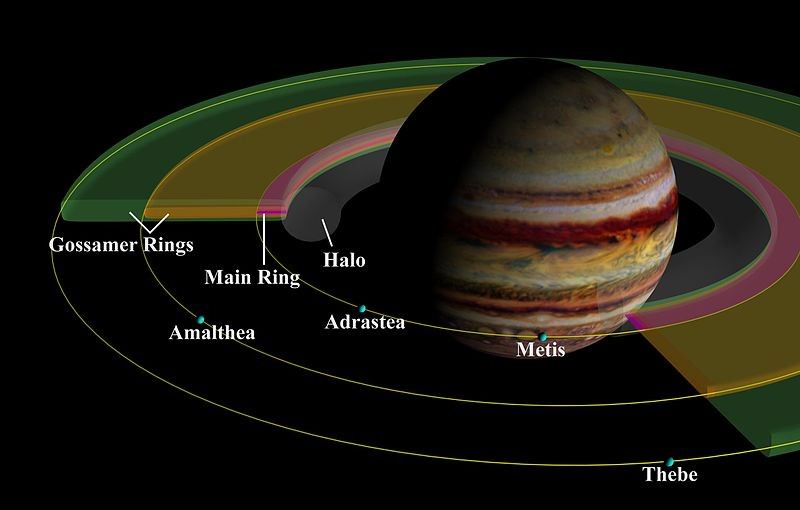 The four main components of Jupiter’s rings. (NASA/JPL/Cornell University)
The four main components of Jupiter’s rings. (NASA/JPL/Cornell University)
Jupiter gets smacked into… a lot
Another side effect of the planet’s strong gravitational pull is that it attracts a lot of impacts. Some of these we have been lucky enough to capture on camera.
Light on at Jupiter! Anyone home? This bright impact flash was spotted yesterday on the giant planet by astronomer José Luis Pereira.
Not a lot of info on the impacting object yet but its likely to be large and/or fast!
Thanks Jupiter for taking the hit☄️#PlanetaryDefence pic.twitter.com/XLFzXjW4KQ
It’s unknown exactly how often Jupiter gets smacked by something large or fast enough to produce an impact flash visible from Earth, but it’s thought to be somewhere between 20 and 60 times per year.
The good news is that the gas giant seems to act as a type of giant cosmic vacuum cleaner, helping to protect our own planet from potentially devastating impacts.
Source: sciencealert








